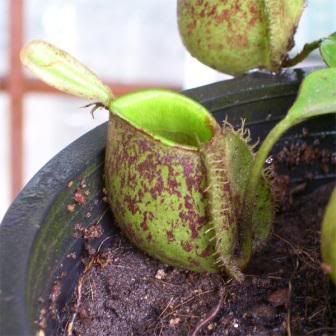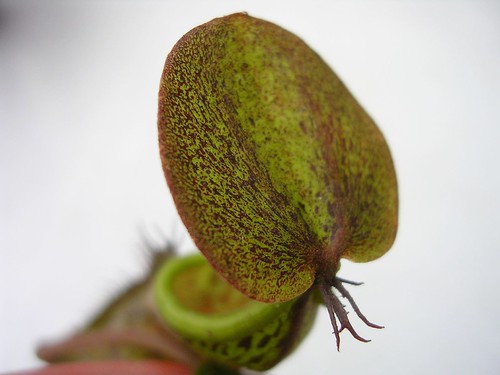
 |
|
|||||||
| Nepenthes Everything about Tropical Pitcher Plants |
|
|
Thread Tools | Search this Thread | Display Modes |
|
#1
|
||||
|
||||
|
PetPitcher Forum :: CARNIVOROUS PLANTS :: Nepenthes :: Fertilising Neps
   You must be logged in to vote in this poll.Yes, organic liquid sprayed on leaves    (0 votes, 0%)Yes, organic liquid fertiliser on media (0 votes, 0%)Yes, organic liquid fertiliser on media   (1 vote, 9%)Yes, organic pellet fertiliser on media (1 vote, 9%)Yes, organic pellet fertiliser on media   (0 votes, 0%)Yes, inorganic foliar fertiliser sprayed on leaves (0 votes, 0%)Yes, inorganic foliar fertiliser sprayed on leaves   (0 votes, 0%)Yes, inorganic foliar fertiliser on media (0 votes, 0%)Yes, inorganic foliar fertiliser on media   (0 votes, 0%)Yes, inorgani compound chemical fertiliser on medi (0 votes, 0%)Yes, inorgani compound chemical fertiliser on medi   (2 votes, 18.1%)Yes, inorganic slow release fertiliser on media (2 votes, 18.1%)Yes, inorganic slow release fertiliser on media   (0 votes, 0%)Yes, a combination of organic & inorganic on media (0 votes, 0%)Yes, a combination of organic & inorganic on media   (4 votes, 36.3%)No, I don't. (i.e. just water and pitcher feeding) (4 votes, 36.3%)No, I don't. (i.e. just water and pitcher feeding)   (4 votes, 36.3%) (4 votes, 36.3%)Poll Totals: Total Votes: 11 Total Voters: 10  AuthorTopic: Fertilising Neps (Read 316 times) bactrus AuthorTopic: Fertilising Neps (Read 316 times) bactrusFull Member    member is offline Joined: Sept 2007 Posts: 235 Location: Penang  Fertilising Neps Fertilising Neps« Thread Started on Feb 15, 2008, 10:08am » Interest was aroused to find out what Nep growers nurture their ****es... whether with or without fertiliser. Results fairly important to newbie like me. To quote artificialive in http://petpitcher.proboards61.com/index.....read=1202974700 "Just wanna bring up this topic becos it seems to me like a controversial subject. Some growers have successfully grown their neps without fertilizers and some, with fertilizers." Link to Post - Back to Top  LoggedBA artificialive LoggedBA artificialivePioneer Member / Global Moderator         member is offline   Joined: Dec 2006 Gender: Male  Posts: 713 Location: Ayer Keroh, Malacca  Re: Fertilising Neps Re: Fertilising Neps« Reply #1 on Feb 15, 2008, 10:26am » Hi Bactrus, Thanks for creating this thread. Appreciate it  As for me, i do not fertilize my neps, but to my logic, i should try using organic pellet ferts, perhaps mimicking their natural habitat where bird and another animals' poo can be found on the ground. But yeah, at the end of the day, it doesn't promise the optimum growth of our plants, is it. Link to Post - Back to Top  Logged[Naj Grow List] --- [Naj Wanted List] ameliepoulain Logged[Naj Grow List] --- [Naj Wanted List] ameliepoulainGlobal Moderator        member is offline   Joined: May 2007 Gender: Female  Posts: 442 Location: Ara River, 11900 Penang  Re: Fertilising Neps Re: Fertilising Neps« Reply #2 on Feb 15, 2008, 11:25am » bactrus, I think you miss out one more method, what I've be advised and tried - feeding the pitcher with osmocote. So far, after 4 weeks - no ill effect + am getting more pitchers. Btw, if I feed organic fertilizer into the pitchers, is that feeding with organics? Link to Post - Back to Top  LoggedAthene's CP Growlist LoggedAthene's CP GrowlistAthene's Wishlist bactrus Full Member    member is offline Joined: Sept 2007 Posts: 235 Location: Penang  Re: Fertilising Neps Re: Fertilising Neps« Reply #3 on Feb 15, 2008, 1:29pm » Anthene, Osmocote, Bastacote, Sumicoat, Vitality Forte, Agroblen etc are slow release or controlled release fertiliers. Wanna try Bastacote? I have some. Gimme a buzz next week when you're around my area. BA Link to Post - Back to Top  LoggedBA ameliepoulain LoggedBA ameliepoulainGlobal Moderator        member is offline   Joined: May 2007 Gender: Female  Posts: 442 Location: Ara River, 11900 Penang  Re: Fertilising Neps Re: Fertilising Neps« Reply #4 on Feb 15, 2008, 2:03pm » Quote:Anthene, Osmocote, Bastacote, Sumicoat, Vitality Forte, Agroblen etc are slow release or controlled release fertiliers. Wanna try Bastacote? I have some. Gimme a buzz next week when you're around my area. BA I'm around you area daily these day my friend! Link to Post - Back to Top  LoggedAthene's CP Growlist LoggedAthene's CP GrowlistAthene's Wishlist artificialive Pioneer Member / Global Moderator         member is offline   Joined: Dec 2006 Gender: Male  Posts: 713 Location: Ayer Keroh, Malacca  Re: Fertilising Neps Re: Fertilising Neps« Reply #5 on Feb 15, 2008, 2:55pm » Athene: How much is the dosage of the osmocote u put in the pitcher, athene? I mean, maybe 2-3 pellets per pitcher? Bactrus: Err whats the difference between all the fert family ure mentioning?  Link to Post - Back to Top  Logged[Naj Grow List] --- [Naj Wanted List] bactrus Logged[Naj Grow List] --- [Naj Wanted List] bactrusFull Member    member is offline Joined: Sept 2007 Posts: 235 Location: Penang  Re: Fertilising Neps Re: Fertilising Neps« Reply #6 on Feb 16, 2008, 10:31am » Just mentioning to Anthene that osmocote is form of controlled release fertiliser mention earlier. Hehe. maybe redundant info. The brands mentioned. Anyone keen to try... prejudice for me to mention which is better. Tried them all normal plants. Link to Post - Back to Top  LoggedBA ameliepoulain LoggedBA ameliepoulainGlobal Moderator        member is offline   Joined: May 2007 Gender: Female  Posts: 442 Location: Ara River, 11900 Penang  Re: Fertilising Neps Re: Fertilising Neps« Reply #7 on Mar 19, 2008, 9:03am » Quote:Athene: How much is the dosage of the osmocote u put in the pitcher, athene? I mean, maybe 2-3 pellets per pitcher? Bactrus: Err whats the difference between all the fert family ure mentioning?  Art, Sorry for the late reply. I put in 1-2 pellet in each pitcher, but for my 1st experiment, I didn't put in all the pitchers of each plant, only a few pitcher each. So far no ill effect. Link to Post - Back to Top  LoggedAthene's CP Growlist LoggedAthene's CP GrowlistAthene's Wishlist phissionkorps Advisor - Nepenthes        member is offline  if you don't grow from seed, toughen up!   Joined: Oct 2007 Gender: Male  Posts: 307 Location: Republic of Texas  Re: Fertilising Neps Re: Fertilising Neps« Reply #8 on Mar 19, 2008, 9:22am » Please let us know if you experience any adverse effects. I sure did, so I only use orchid fert now (19-31-17). Link to Post - Back to Top  LoggedNatura non facit saltum LoggedNatura non facit saltumSpecies seed is worth its weight in platinum Valhalla when I die rainforestguy Senior Member     member is offline Joined: Jul 2007 Posts: 386  Re: Fertilising Neps Re: Fertilising Neps« Reply #9 on Mar 20, 2008, 1:07am » I can solve many problems for misuse of fertilizing. Do not add chemical fertilizers to pitchers. A pitcher's method for nutrient absorption is strictly for nitrogen and related enzymes released from microorganism breakdown. thus breakdown of organic base compounds. If one notices the roots of nepenthes, you will notice that they have black, fine roots almost like a netting. Whether it is derived from a tuberous rootstock (i.e. thorelii, sp. Viking, et al) fine black roots are still produced. Even epiphytic species has these fine black roots. When a root is fine and networking, it is seeking minute diluted forms of nutrients. These roots also absorb more than NPK. They utilize metals and salts also found in the soils. These are not derived from pitcher feedings. Plants from ultramafic soils or soils high in calcium require root absorption for these minerals to be beneficial to the plant. Since these plants all come from regions of heavy or seasonal rainfall, it is through this application for absorption that needs to be addressed. Timed-release fertilizers are not safe due to their release not based on moisture, but many times on temperatures and humidity that has nothing to do with free water that is required for absorption. If the temperatures soars high, many coatings of timed release stuff will release fertilizers even when no water is present as a carrier for dilution or root absorption. Introducing timed release fertilizers into a pitcher just makes them release the nutrients and NPK at once. Many times this will burn the pitchers as the salts and metal and or mineral compounds will be in too large a concentration and may also kill enzymatic microorganisms present in the pitchers. Foliar feedings are usually a waste of time with just minerals or some salt compounds being absorbed through leaf membranes, again nutrients needing to be broken down to usable compounds before the plant can make functional use out of it. This cannot occur anywhere except in the soil level where these microbes are present. Use a diluted organic base nutrient solution. Avoid Miracle Grow as these contain more salts than actual nutrients. I have found Peters a good source for chemical base nutrients and GrowMore Liquid Seaweed Extract very beneficial as an organic low salt formulation. I am sure there are other good seaweed sources and recommend these highly. The seaweed blends also contain microorganisms present in it that will aid in breakdown of nutrients once introduced in the soil. Regarding ammonia, I have not found it adversely harmful to nepenthes. So long as it is given with ample water and leaching effects after use, there are no harmful effects from prolonged use. The soil bacteria also breaks down the nitrogen cycle effectively and easily by simple chemical decomposition and produces usable nitrogen compounds. But watering with plain water daily, or as watered, is an important criteria for any nutrient program to work efficiently. While NPK is important the salts used as carriers is not and these may remain in the soils to toxic levels. Michael Link to Post - Back to Top  Loggedhttp://www.lhnn.proboards107.com/index.cgi Loggedhttp://www.lhnn.proboards107.com/index.cgi
|
| Currently Active Users Viewing This Thread: 1 (0 members and 1 guests) | |
| Thread Tools | Search this Thread |
| Display Modes | |
|
|